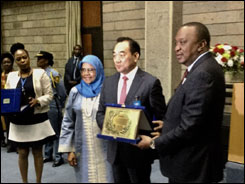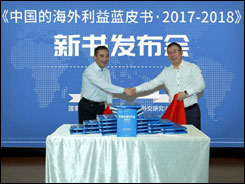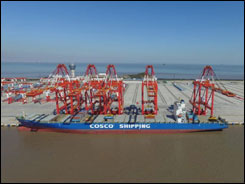China-ASEAN Cooperation in 2012
The year 2012 marks the 10th anniversary of the signing of the Framework Agreement on China-ASEAN Comprehensive Economic Cooperation and the year of China-ASEAN science and technology cooperation. Through the concerted efforts of the two sides, the initiatives announced by leaders of the two sides at last year's Commemorative Summit to Celebrate the 20th Anniversary of China-ASEAN Dialogue Relations have been or are being vigorously implemented. Progress has been made in the development of the China-ASEAN FTA and cooperation in science and technology, the environment, culture and education, and many other fields, taking China-ASEAN strategic partnership to a higher level.
I. Political Exchange, Defense and Security
High-Level Exchanges
China and ASEAN have maintained close high-level contacts in 2012. Some 50 mutual visits by officials at or above deputy-prime-minister level were made between the two sides. These visits have further strengthened strategic mutual trust, communication and coordination.
Foreign Minister Yang Jiechi attended the ASEAN Post Ministerial Meetings in Phnom Penh in July and reaffirmed China's policy of promoting good-neighborly and friendly relations and mutually beneficial cooperation with ASEAN.
In order to set up a contact mechanism with ASEAN, China opened a mission to ASEAN in Jakarta, Indonesia and appointed Mme. Yang Xiuping as Chinese Ambassador to ASEAN. The Chinese Mission to ASEAN was inaugurated on September 27.
The two sides have maintained close communication and coordination on major global and regional issues within multilateral organizations, including the UN, G20, APEC and East Asia Summit, to work for the establishment of a fair and just international political and economic order, making positive contributions to regional peace, stability and prosperity.
Cooperation in the South China Sea
The year 2012 marks the 10th anniversary of the signing of the Declaration on the Conduct of Parties in the South China Sea (DOC). There is a generally good momentum of implementation of the DOC. China and ASEAN countries held the fourth senior officials meeting and seventh working group meeting on the implementation of the DOC in Beijing in January and the fifth senior officials meeting in Hanoi in June. Participants reached broad common ground on implementing the DOC and advancing practical cooperation in the South China Sea.
According to the 2012 Working Plan adopted at the fourth senior officials meeting, China hosted the seminar on marine disaster prevention and mitigation in the South China Sea and the seminar on marine ecological environment and surveillance technology in the South China Sea.
China and ASEAN countries have maintained communication over discussions on a code of conduct in the South China Sea (COC). Senior officials held informal consultations on COC on July 8 and September 13 respectively. By discussing relevant issues, parties have enhanced mutual understanding and expressed the desire to jointly uphold peace and stability in the South China Sea. China also attended the Track 1.5 seminar on COC held by think tanks of ASEAN countries in Malaysia and exchanged views with other parties over relevant issues.
Defense and Security
On May 29, Chinese State Councilor and Defense Minister Gn. Liang Guanglie attended the first China-ASEAN Defense Ministers' Consultation in Phnom Penh, Cambodia. Parties exchanged views on the security situation in the region and discussed ways to deepen mutual trust and cooperation.
In May, police of China and seven ASEAN countries, including Thailand, Malaysia, Cambodia, Indonesia and the Philippines, jointly busted the "November 29" major telecom fraud gang and arrested 482 suspects, which effectively curbed the rampancy of such crime.
Police departments of the two sides have maintained close exchanges and communication through various seminars and workshops. China sent a delegation to the 32nd ASEAN Chiefs of Police Meeting held in Naypyidaw, Myanmar in May. The China-ASEAN senior police officers workshop was held in Zhejiang, China in June. The ninth China-ASEAN investigation technology training program was held in Beijing from June to August. China also plans to hold senior law-enforcement officers workshop in the year and invite law-enforcement officers of ASEAN countries to the workshop.
II. Business and Investment
China-ASEAN two-way trade grew by 23.9% to US$362.85 billion in 2011. ASEAN became China's third largest trading partner, the fourth largest export market and the second largest source of import. China remained ASEAN's largest trading partner for the third consecutive year. In the first 9 months of 2012, two-way trade hit US$288.98 billion.
China-ASEAN two-way investment has kept growing, totaling US$94 billion by the end of September, 2012. Chinese enterprises have set up 5 overseas economic cooperation zones in Cambodia, Thailand, Vietnam and Indonesia since 2006, with a total planning area of 31 square km. By the end of July, 2012, US$934 million have been invested and 91 enterprises have established businesses in the economic zones, producing an output of US$1.45 billion and creating nearly 8,000 jobs.
By the end of July, 2012, Chinese enterprises have signed project contracts worth US$134.9 billion in ASEAN countries and generated a turnover of US$87 billion.
The Ninth China-ASEAN Expo
The ninth China-ASEAN Expo was held in Nanning, Guangxi from September 21 to 25, 2012. Vice President Xi Jinping, President U Thein Sein of Myanmar, the theme country of the Expo, Lao Prime Minister Thongsing Thammavong, Vietnamese Prime Minister Nguyen Tan Dung, Malaysian Deputy Prime Minister Muhyiddin Mohamad Yassin and Thai Deputy Prime Minister Kittiratt Na-Ranong, Special Envoy Roxas of Philippine President, Deputy Secretary-General Lim Hong Hin of the ASEAN Secretariat, and Secretary-General Supachai of the UNCTD attended the Expo.
The ninth China-ASEAN Business and Investment Summit and the Forum on China-ASEAN FTA were also successfully held in Nanning during that period. The theme of the summit is "Connectivity for Win-Win". Vice President Xi Jinping attended the opening ceremony and delivered a keynote speech entitled Work Together Towards Deeper Cooperation and Sustained Development. Myanmar President U Thein Sein attended and addressed the opening ceremony of the summit.
III. Financial Cooperation
On May 17, 2012, the State Development Bank (SDB) of China hosted the second meeting of the Council of China-ASEAN Inter-bank Association in Beijing. Member banks of the Association signed the Supplement Agreement on China-ASEAN Inter-Bank Association Cooperation, had an in-depth exchange on strengthening cooperation, and discussed the feasibility of providing financing support to major projects in the fields of infrastructure, power, agriculture, SMEs, energy resources as well as conducting cooperation on local currency settlement and capital transaction, thus laying the foundation for further cooperation.
IV. Science and Technology,
Environmental Protection, and
Intellectual Property Rights
Science and Technology
The year 2012 is the year of China-ASEAN science and technological cooperation. China and ASEAN held a host of activities themed on science and technology.
On May 18, the seventh meeting of China-ASEAN Joint Science and Technology Committee was held in Myanmar's capital city Naypyidaw. On September 22, the first China-ASEAN science and technology ministers meeting was held in Nanning, Guangxi. Chinese Science and Technology Minister Wan Gang, science ministers of the ten ASEAN countries, and senior officials of the ASEAN Secretariat attended the meeting. The China-ASEAN Science and Technology Partnership Program was formally launched in Nanning on the same day. The project of jointly building a platform for sharing resources satellite data, the first project under the science and technology partnership program, was also launched. The workshop on science and technology policy and management for ASEAN countries and the China-ASEAN Forum were held in China in October and November respectively.
Environmental Protection
In 2012, China and ASEAN actively implemented the China-ASEAN Environmental Protection Cooperation Strategy, drew up the Action Plan of China-ASEAN Environmental Cooperation, and carried out such activities as policy dialogue, capacity building and research on regional environmental cooperation.
Implementing the China-ASEAN Green Ambassador Plan
The plan aims at, through seminars and exchanges, improving the environment management ability of government decision-makers, enhancing the environmental awareness of the public, promoting exchanges between the youth of the two sides in the field of environmental protection, and advancing innovation of environmental friendly technology.
The China-ASEAN Youth Seminar on Green Development was held in Beijing between May 22 and 24, 2012. The China-ASEAN workshop on green economy and environment management was held in Beijing from July 15 to 21, 2012.
Implementing the China-ASEAN Cooperation Plan of Biological Diversity and Ecological Protection
On September 18, 2012, the China-ASEAN seminar on the practice of biological diversity protection was held in Beijing, where participants exchanged views and shared experience on the successful practice of protecting biological diversity.
Intellectual Property Rights
In 2012, China and ASEAN have conducted extensive and in-depth exchanges and cooperation in intellectual property rights (IPR).
In order to promote China-ASEAN dialogue on IPR development at the global, regional and national levels and implement the Memorandum of Understanding between the Government of the People's Republic of China and Governments of the Member Countries of the Association of Southeast Asian Nations on Intellectual Property Rights Cooperation, China hosted the 2012 China-ASEAN Seminar on the Protection of Intellectual Property Rights, Traditional Knowledge and Genetic Resources in Beijing from September 10 to 12. Participating IPR officials, experts and scholars from China and ASEAN countries discussed the protection of traditional knowledge and genetic resources and expressed desire for closer cooperation in this field.
V. Information and Communication
Technology and Civil Aviation
Information and Communication Technology (ICT)
China and ASEAN have carried out steady exchanges and cooperation in ICT since the beginning of the year.
China participated in the working group meeting of China-ASEAN ICT senior officials meeting in March and the roundtable meeting of China-ASEAN telecommunications regulatory council in July, and exchanged views with other parties over ICT development and regulation policy and ICT cooperation projects between China and ASEAN.
In January, the China-ASEAN training course on broadband communications technology and application was held in Shenzhen. In June, the China-ASEAN seminar on IT-application in SMEs was held in Lianyungang, Jiangsu Province. In September, the China-ASEAN seminar on distance education and the China-ASEAN seminar on broadband wireless mobile communications technology and application were held in Nanning and Beijing respectively.
China plans to host the China-ASEAN training course on cloud computing technology and application and China-ASEAN seminar on cyber security in the year. Representatives from competent ICT authorities of ASEAN countries and the ASEAN Secretariat will be invited. These activities have helped the exchange of experience and capacity building on information development and cyber security between the two sides.
Civil Aviation
The two sides held the sixth working group meeting on China-ASEAN regional air services arrangement in 2012 to continue consultation on further expanding China-ASEAN regional air transport arrangement.
The sixth working group meeting between the Civil Aviation Administration of China (CAAC) and ASEAN on regional air transport arrangement was held in Kunming, Yunnan Province from September 10 to 14, 2012. Participants had consultations on the second protocol to the China-ASEAN Air Transport Agreement (CAATA) which concerns the fifth freedom traffic rights between China and ASEAN and those between the two and a third country.
China will host the China-ASEAN seminar on the management of civil aviation operation safety in Yunnan in November and train 20 management professionals in civil aviation safety for ASEAN countries.
China will also host the China-ASEAN seminar on airport and airspace capacity assessment in Tianjin within this year and train 20 management professionals in air traffic for ASEAN countries.
The 11th China-ASEAN transport ministers meeting and senior officials meeting will be held in Indonesia in November. The Civil Aviation Administration of China will attend the meeting and report on the civil aviation cooperation between China and ASEAN over the past year and the latest developments.
VI. Culture, Education and Tourism
Culture
The first China-ASEAN Culture Ministers Meeting was held in Singapore on May 25, 2012. Participants agreed to establish the China-ASEAN culture ministers meeting mechanism and discussed matters related to the operation of the mechanism, cultural cooperation in the coming period and the Action Plan of China-ASEAN Cultural Cooperation.
The two sides have successfully held the China-ASEAN Cultural Industry Forum six times since 2006, making positive contributions to resource sharing and practical cooperation on regional cultural exchanges as well as deepening China-ASEAN relations. The forum was renamed "China-ASEAN Cultural Forum" and the latest one was held in Nanning from September 10 to 14 in 2012.
Education
China-ASEAN Education Exchange Week
Themed "Openness, Innovation and Practical Cooperation", the fifth China-ASEAN Education Exchange Week was opened from September 17 to 20 in Guizhou Province, with concurrent activities such as China-ASEAN university presidents forum, China-ASEAN food culture festival, China-ASEAN seminar on the development of cultural industry, and China-ASEAN forum on medical education. Over 600 representatives from ASEAN universities, educational authorities, embassies of ASEAN countries,the ASEAN-China Centre, the ASEAN Secretariat, the ASEAN University Network and many Chinese universities participated in the activities.
Ten China-ASEAN Vocational Education and Training Centers
At the 14th China-ASEAN Summit in 2011, Premier Wen Jiabao proposed to "set up 10 vocational education and training centers to help ASEAN countries develop human resources needed in economic and social development". All the ten China-ASEAN vocational education and training centers have now been established in different provinces and autonomous regions such as Guangxi, Sichuan, Yunnan, Guizhou, Fujian and Heilongjiang, providing training courses on business exhibition, culture, art, Chinese language teaching, finance, traditional medicine, and new energy.
Double 100,000 Students Plan
By the end of 2011, the number of students from the ten ASEAN countries studying in China totaled 54,790, including 4,118 students on Chinese government scholarships. The number of Chinese students studying in ASEAN countries registered 101,039. In 2012, China continues to provide more scholarships for ASEAN countries and put into practice the Plan of Studying in China to attract more students from ASEAN countries to study in China and encourage mutual exchange of students between China and ASEAN.
Chinese Language Teaching and ASEAN Research
China attaches importance to strengthening Chinese language teaching in ASEAN countries. So far, China has opened 26 Confucius Institutions and 14 Confucius Classrooms in Cambodia, Laos, Malaysia, Myanmar, Indonesia, the Philippines, Singapore and Thailand.
China has also strengthened ASEAN-related research. Many Chinese universities, including Peking University, Beijing Foreign Studies University, Xiamen University, Guizhou University, Yunnan University, have set up research centers on ASEAN or ASEAN countries. Dozens of Chinese universities are now offering programs on the language of ASEAN countries. The number of Chinese students learning ASEAN languages keeps growing. There are increasingly frequent academic exchanges between Chinese and ASEAN universities.
Tourism
In recent years, the National Tourism Administration (NTA) of China gives preferential treatment to ASEAN countries and the ASEAN Secretariat attending the China International Travel Mart every year. In 2012, the NTA continues to provide two free standard exhibition booths to each participating ASEAN country and the ASEAN Secretariat. The booths are located near to each other. China also gives active support and assistance to ASEAN countries' special promotional activities during the event.
In February, the National Development and Reform Commission of China (NDRCC), the ASEAN-China Centre (ACC) and NTA co-hosted the first China-ASEAN Green Tourism Forum in Beijing. In April, assisted by the NTA, the ACC and a TV crew from China Central Television (CCTV) went to Cambodia and shoot a film of its tourism attractions which was aired on CCTV.
VII. Health, Customs and Quality
Supervision, Inspection and Quarantine
Health
On March 29, 2012, the second China-ASEAN senior officials meeting on health development was held in Cebu, the Philippines. On July 6, the fourth China-ASEAN Health Ministers Meeting was held in Phuket Island, Thailand. Participants identified the priority areas for bilateral health cooperation, shared experience over smoking control and signed the Memorandum of Understanding between the Government of the People's Republic of China and Governments of the Member Countries of the Association of Southeast Asian Nations on Health Cooperation.
In April, the China-ASEAN Seminar on Traditional Medicine under the theme of "incorporating traditional medicine into the national healthcare system" was held in Beijing.
In August, China invited ASEAN countries to attend the China Health Forum held in Beijing to share experience over the reform of healthcare.
In 2012, the two sides also carried out programs on HIV/AIDS prevention and control, in border areas of China and Myanmar, China and Vietnam, and China and the Laos; the pilot cooperation program of cross-border joint prevention and control of malaria/dengue fever in the border areas of the Yunnan Province in the Greater Mekong Subregion and the pilot program of prevention and control of dengue fever in the border areas in the Greater Mekong Subregion.
Customs
The 10th China-ASEAN Customs Directors Consultation was held in Manila, the Philippines from June 5 to 9, 2012. Participants exchanged views on strengthening capacity building, promoting the safety and facilitation of international supply chain, and matters related to the World Customs Organization and the World Trade Organization.
In June, the Seminar on China-ASEAN Customs "Authorized Economic Operator (AEO)" was held in Guilin, Guangxi.
In September, the training course on follow-up customs inspection was held in Shanghai and 20 senior customs officials from four countries took part in the course.
Quality Supervision, Inspection and Quarantine
From September 19 to 21, 2012, the third China-ASEAN Ministerial Meeting on Quality Supervision, Inspection and Quarantine (SPS Cooperation) was held in Nanning, Guangxi under the theme of "strengthening cooperation to serve the development of China-ASEAN FTA". The meeting reviewed and approved the Implementation Plan (2013-2014) of the China-ASEAN MoU on SPS Cooperation (SPS-MoU), identified the major China-ASEAN cooperation projects in SPS in the coming two years, and issued the Joint Press Statement of the Third China-ASEAN Ministerial Meeting on Quality Supervision, Inspection and Quarantine (SPS Cooperation).
On September 20, the China-ASEAN SPS Cooperation Information Web jointly developed by the two sides was officially launched, which included sections such as news center, ministerial meeting, technical working groups, SPS regulation, pest risk, concurrent activities and relevant SPS agreements.
VIII. Development of the Greater Mekong
Subregion (GMS)
Trade and Investment
China have taken an active part in and vigorously promoted the construction of the GMS economic corridor. At the fourth GMS Economic Corridor Forum held in Mandalay, Myanmar on June 28, 2012, China put forward a series of proposals on the construction of the GMS economic corridor, including promoting the construction of transport corridor, Pan-Asia railway, industrial parks, cross-border cooperation zone, trade facilitation and information superhighway, realizing full connectivity, and strengthening the capacity building on economic corridor cooperation. China also hosted a workshop of trade facilitation officials for GMS countries in the first half of the year and plans to train 1,500 professionals for GMS countries in the coming three years.
Environment
China attaches great importance to environment cooperation and exchanges with GMS countries. China has taken an active part in the study and formulation of the second phase framework document and action plan (2012-2016) of the Core Environment Program-Biological Diversity Corridor Initiative (CEP-BCI) (2006-2011). The 18th annual meeting of the GMS environment working group held in Jinghong City, Yunnan Province of China in May, adopted the general action plan of the second phase of the CEP and kicked off the implementation of the program.
Transportation
The third bridge over the Mekong River (Chiang Khong-Houayxay Bridge) linking the Laos and Thailand on the west route of the GMS North-South Economic Corridor (Kunming-Laos-Bangkok highway) was jointly funded by the Chinese and Thai governments. The construction of the bridge started in February, 2012 and is expected to finish and open for traffic in June, 2013. The Chinese section of the middle route of the corridor (Kunming-Hanoi-Haiphong), which is 407 km in length, has been upgraded to expressway standards. The Chinese section of the 1208-km-long east route of the corridor (Kunming-Nanning-Hanoi), which is 179 km in length, has been upgraded to expressway standards.
China has engaged in close cooperation with ASEAN countries. In order to facilitate road transportation between the ports of the two countries, China and Vietnam signed the Agreement on Permitting Licenses for International Road Transportation in Beijing in May, 2012, agreeing to open four passenger routes and one freight route linking the Chinese and Vietnamese ports. The opening ceremony of the routes was held in August, 2012.
IX. Poverty Alleviation and Social
Development
On September 26 and 27, 2012, the sixth China-ASEAN Forum on Social Development and Poverty Reduction under the theme of "China and ASEAN: Inclusive Development and Poverty Reduction" was held in Guangxi.
From September 13 to 15, the seventh China-ASEAN Senior Officials Meeting on Social Welfare and Development under the theme of "promoting social welfare and security for the disadvantaged people" was held in Hanoi.
China will also host the China-ASEAN seminar on spatial information products sharing in disaster risk mitigation in the year and co-host with the ASEAN Secretariat the China-ASEAN high-level seminar on the standardization of public service in social security, where participants are expected to discuss the design and operation of public service in social security.
X. Youth Exchange
C China will organize four training courses for young ASEAN government officials in 2012 and train 200 young government officials for ASEAN. Three courses have been completed.
In May, the eighth Lancang-Mekong River Youth Friendly Exchange Program was held in China, Thailand and Cambodia, joined by 68 youth representatives from the six GMS countries, including 11 from China. The program has been held eight times so far with the participation of 519 youth representatives from the six GMS countries.
China plans to host the seventh China-ASEAN Youth Camp in November and invite 100 young people from the ten ASEAN countries to visit China.
China have sponsored a host of China-ASEAN student summer (winter) camps, the Chinese Bridge language competitions and other programs to encourage universities in China's border provinces to actively engage with their counterparts in ASEAN countries. Nearly 1,000 youngsters from ASEAN countries visit China each year, contributing to the mutual understanding and friendship between the younger generation on the two sides.



















